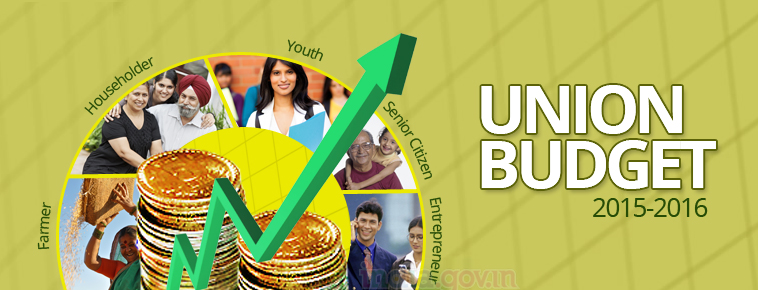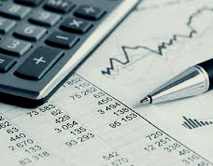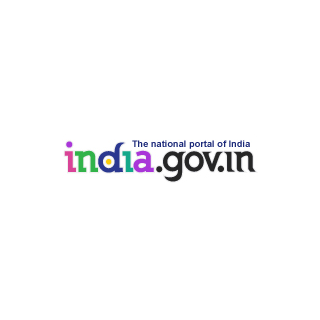
Government Budget is designed for optimal allocation of resources. The Union Budget is presented to the Parliament in two parts:
- Railway Budget pertaining to "Railway Finance".
- General Budget which gives an overall picture of financial position of the Government of India. It includes the effect of "Railway Budget"
Union Minister for Finance Shri Arun Jaitley on 28th February presented in Parliament the Union Budget 2015-16, with a focus on growth, promoting entrepreneurship and manufacturing, rationalizing tax regime and announcing some relief to common man.
Budget Estimate
- Non-Plan expenditure estimates for the Financial Year are estimated at Rs.13,12,200 crore.
- Plan expenditure is estimated to be Rs.4,65,277 crore, which is very near to the R.E. of 2014-15.
- Total Expenditure has accordingly been estimated at Rs.17,77,477 crore.
- The requirements for expenditure on Defence, Internal Security and other necessary expenditures are adequately provided.
- Gross Tax receipts are estimated to be Rs.14,49,490 crore. Devolution to the States is estimated to be Rs.5,23,958 crore. Share of Central Government will be Rs.9,19,842 crore. Non Tax Revenues for the next fiscal are estimated to be Rs.2,21,733 crore.
- With the above estimates, fiscal deficit will be 3.9 per cent of GDP and Revenue Deficit will be 2.8 per cent of GDP.
Three Key achievements
- Financial Inclusion - 12.5 crores families financially mainstreamed in 100 days.
- Transparent Coal Block auctions to augment resources of the States.
- Swachh Bharat is not only a programme to improve hygiene and cleanliness but has become a movement to regenerate India.
- Game changing reforms on the anvil:
- Goods and Service Tax (GST)
- Jan Dhan, Aadhar and Mobile (JAM) - for Direct Benefit Transfer
Major Challenges Ahead
- Five major challenges: Agricultural income under stress, increasing investment in infrastructure, decline in manufacturing, resource crunch in view of higher devolution in taxes to states, maintaining fiscal discipline.
- To meet these challenges public sector needs to step in to catalyse investment, Make in India programme to create jobs in manufacturing, continue support to programmes with important national priorities such as agriculture, education, health, MGNREGA, rural infrastructure including roads.
- Challenge of maintaining fiscal deficit of 4.1% of GDP met in 2014-15, despite lower nominal GDP growth due to lower inflation and consequent sub-dued tax buoyancy.
Highlights of the Budget
-
 Economy
Economy - India set to be the fastest growing large economy in the world. Double digit growth seems feasible. Real GDP expected to accelerate to 7.4% during the current fiscal. Foreign Exchange reserves at $340 billion.
-
 Public Finance
Public Finance - Fiscal deficit target of 3% to be achieved over next three years, instead of two. 4.1 % target being met this year, despite tax buoyancy being lower. Roadmap to achieve Fiscal deficit of 3% of GDP in three years: Target is 3.9% in 2015-16, 3.5% in 2016-17, 3% in 2017-18.
- Following 14th Finance Commission recommendations, states will get higher resources. 68% of total revenues will now be in the hands of states, ushering in an era of cooperative federalism.
- Budget Estimates of Expenditure: 17 .77 lakh cr, of which Non Plan is 13.12 lakh cr, and Plan is 4.65 lakh crores
- Direct Tax collection to be 14.49 lakh crore rupees
-
 Taxation and Tax regime
Taxation and Tax regime - GST to put in place state of art indirect tax system by April 1st 2016.
- Internationally competitive Direct Tax regime to be put in place, which will be stable and non-discriminatory.
- Applicability of GAAR deferred by two years; will only apply prospectively after Apr 2017
- Basic rate of Corporate Tax to be reduced from 30% to 25% in next 4 years; to be accompanied by reducing exemptions
- Wealth Tax to be abolished; 2% surcharge on super-rich having income over Rs.1 crore. This will net an additional tax revenue of Rs.9,000 crores
- Service Tax increased to 14%.
- Custom duty on raw materials and intermediaries to be reduced
- Clean energy cess increased from 100 to 200 Rupees per metric ton of coal to finance Green Energy Fund. Renewable energy target revised to 175,000 Mw.
- Direct tax proposals will lead to loss of Rs.8,315 cr; Indirect proposal will yield Rs.23,383 cr;
-
 Personal Finance
Personal Finance - Govt. to introduce Gold Monetization Scheme, Sovereign Gold Bonds and Gold coins with Ashok Chakra
- For contribution to National Pension Scheme, exemption raised from Rs.1,00,000 to Rs.1,50,000
- Increase in limit of deduction of health insurance premium from Rs.15,000 to Rs.25,000; It will be Rs.30,000 for senior citizens:
- All contributions to Sukanya Samridhi Scheme to be tax free.
- Individual tax payer will benefit to the extent Rs.4,44,200/- from the exemptions announced
Sectoral Highlights

-
 Agriculture & Rural Development
Agriculture & Rural Development - Rs.5300 crores to be spent on micro-irrigation
- Target of 8.5 lakh crores credit to be given to farmers in 2015-16
- Rural Infrastructure Development Fund to be Rs.25000 Crores
- Highest ever allocation for MGNREGA, by increasing it this year by 5,000 crore rupees
-
 Industry & Infrastructure
Industry & Infrastructure - Focus on making India a manufacturing hub to ensure employment to our youth. Make In India to promote entrepreneurship by making our youth job creators than being job seekers.
- National Investment & Infrastructure Fund announced.
- PPP model to be revised and revitalized. Public investment to be stepped up to catalyze private investments.
- Increased Budgetary allocation to Roads & Railways; Tax-free infra bonds for Rail, Roads transport projects
- 5 Ultra Mega power projects, of 4000 MW announced
- Ports in public sector will be encouraged to corporatize & become companies under companies act
-
 Banking & Finance
Banking & Finance - Mudra Bank to be set up to refinance micro finance institution under PMs Mudra Scheme, with a corpus of Rs.20,000 crores. It will fund the unfunded entrepreneurs.
- Government to do away with distinctions between FII and FDI and replace it with Composite Caps.
- Government to utilize vast postal network for increasing access to institutional banking in order to promote financial inclusion.
-
 Governance
Governance - Comprehensive new law to track black money to be framed. 10 years rigorous imprisonment proposed under the law.
- Benami transaction prohibition Bill to be introduced in this session
- Forward Markets Commission to be merged with SEBI to create a better integrated regulatory system.
- Govt. to bring a Comprehensive Bankruptcy code for the ease of doing business by 2015-16
- Govt. plans an expert committee for Drafting Legislation for Regulatory mechanism
-
 Social Welfare
Social Welfare - Better targeting of subsidies is the need of the hour. Direct Benefit Transfer scheme to be scaled up many folds to ensure plugging of leakages.
- Government to launch PM Suraksha Bhima Yojana, offering coverage of 2 lakh rupees for just premium of Rs.12. PM Surakhsha Bhima Yojana to increase the access to insurance ; it will be linked with Jan Dhan Yojana.
- Senior citizens welfare fund to subsidise the premium for elderly people.
- Nai Manzil - A new scheme for empowering minority youth announced.
- Under Swachch Bharat, 50 lakh toilets have already been built, 6 crore toilets targeted to be constructed.
-
 Human Resource Development
Human Resource Development - AIIMS to be set up in J&K, Punjab, Tamil Nadu, Himachal Pradesh and Assam.
- ISM Dhanabad will be upgraded to full IIT. Karnataka to get a new IIT.
-
 Defence
Defence - Government has already permitted FDI in defence so that the Indian-controlled entities also become manufacturers of defence equipments. The Make in India policy to achieve greater self-sufficiency in the area of defence equipment, 18 including aircraft. The budget allocation for 2015-16 is Rs.2,46,727 crore.
-
 Tourism
Tourism - Resources to be provided to start work along landscape restoration, signage and interpretation centres, parking, access for the differently abled , visitors' amenities, including securities and toilets, illumination and plans for benefiting communities around them at various heritage sites.
- Visa-on-Arrival facility to be increased to 150 countries from the present 43, to promote tourism.
Related Links












 Economy
Economy


